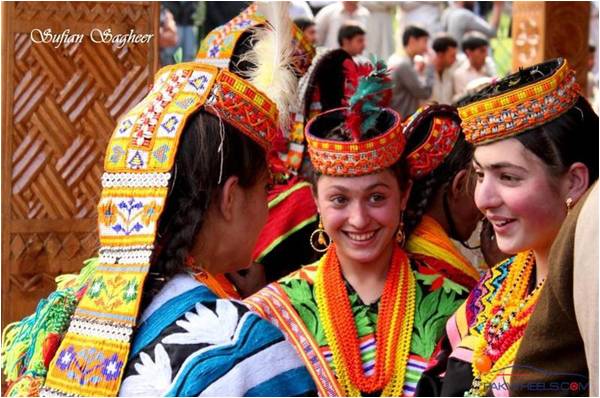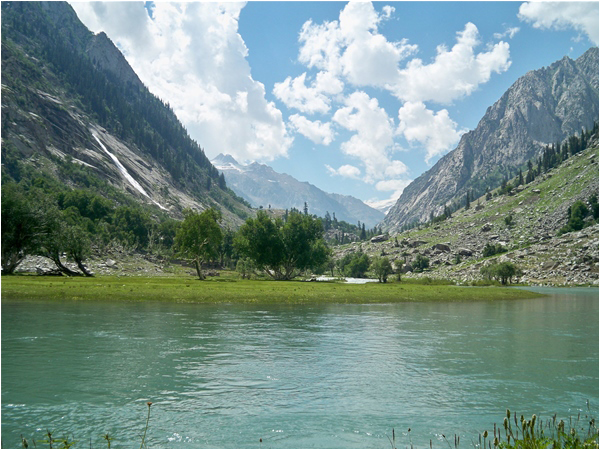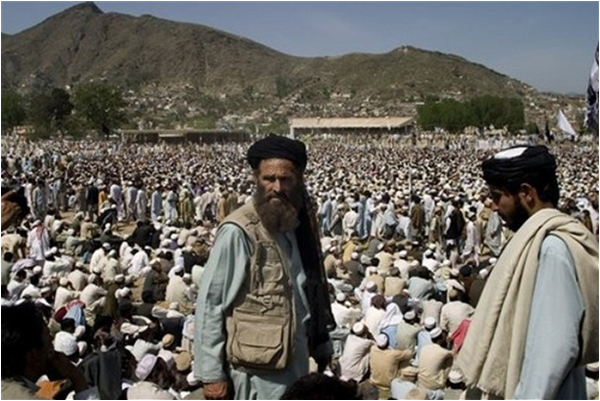
Canopied by shady trees, circled by crystal clear water on its east and lush green fields, the shrine of ‘Ningwalai Baba’, a local sufi of Ningwalai village, burst with sound of women chattering endlessly dressed in their best attire swinging, laughing, munching and nibbling whatever was available with female vendors inside the hallowed place. It was not a visual taken from a Bollywood film. The site of female festivity was Swat, where women from various villages stretched Eid into a three-day event celebrating it from morning to evening. These female celebrations on each Eid festival continued till the end of 1970s.
Compared to the currently diminished social spaces, traditionally, though segregated, women of Swat had leisure opportunities in tribal as well as in state era. Women converged in droves, mostly shrines, from all the villages for Eid festivals without restraint or fear of molestation.
The Valley is a repository of the footprints of Aryans, Greek, Mauryan, Kushans, Turki Shahi, Hindu Shahi and Afghan civilizations as a consequence of direct or indirect influences and rule.

Every civilization brought its own values of socio-political and belief system that added a distinct layer to its recorded and unrecorded history. Relics and archeological sites by endowed by different civilizations remained intact during various political upheavals. The statues of the smiling Buddha in Jahan Abad and at Ghalegai on the main route, presently the Grand Trunk (GT) road, did not pose a threat to the faith of the victorious army of the Ghaznavid emperor, Mehmood Ghaznavi, in 11th century and later Yusufzai in the 16th century. But sadly the symbols denoting a Valley resting on multi-faith and multiculturalism were defaced by the Salafi Taliban during their control on Swat (2007-9).
The same defacement of the sufism can be seen shrouding Ningwalai Baba’s shrine, which now stands forcibly abandoned, divested of female liberating festivities. The sounds of joviality are brutally muted to eradicate a culture of freedom and local identity.
“I don’t know about the entire Swat but our surrounding villages of Ningwalai, Koz Kanju in Kabal Tahsel and Pir Kaley in Matta were famous among women for Eid celebrations. Irrespective of class and status, Eid was celebrated as a communal occasion by all the women. But it vanished once that man with the long teeth came to power,” my mother’s ill-concealed contempt was undeniably geared towards General Zia-ul-Haq.
In the pre Swat state era (1915), the sanctity of such spaces was tantamount to family honor and was a matter of all for one and one for all for protection. Later, the Swat state further reinforced it by ensuring exemplary protection for such spaces and occasions.
Every spring season was another outdoor leisure opportunity wherein the neighborhood women would go out to the fields in the afternoon to collect spinach, more as a pretense than substance. But they were socially accepted, respected and protected activities.
I remember cliques of youth from my village would come to Swat River in summer. Every picturesque spot in Swat throbbed with melodious music in summer and in winter the hujra and bhattaks resounded with the sound of rabbab and mangay. Any celebration, particularly a wedding, was considered incomplete or dull without dance and music.
Hailing from the Yousafzai tribe which had settled in Swat nearly 500 years ago, my mother had witnessed many Eid celebrations of similar nature. But I, as a child, can recall a few gradually fading celebrations. As I grew older and developed a sense of my surroundings, the sounds of celebrations ceased. I longed for the familiarity of joviality through the courtyards of the shrine, but none was to be heard. Those unrestrained sounds had been silenced!
Despite the predominant Sunni sect following, people of Swat observed the 9th and 10th of Moharram (Ashura). Women were conspicuous in narrating marsiyas either within their houses or clustered in a neighborhood. Younger girls of the Cham grouped in the Dalawn (open space) for narrating marsiyas and prepared niyaz, (food offering), mostly baked rice garnished with dry fruit. Commemorating Ashura became a biddat after the onslaught on the society by the Wahabi sect of Islam in the 1980s. The political and cultural strangulation of Swat was fast becoming a nightmarish reality.

Since the 16th century, the Yusufzai of Swat jealously defended their independence from Mughal, Sikh and later from the direct physical occupation of the British. The independence provided opportunity to them to devise and evolve their own distinct socio-political system with representative and egalitarian characteristics at a time of rampant imperialism and authoritarianism. To ensure equity of resources they devised a land tenure system subject to periodic interchange of land after every decade or as agreed by the concerned branches of the tribe. Every tal (a cluster of 40 to 150 households) had the right to elect its own Malik responsible for his tal socio-political affairs while mosques were regulated by the Hujara.
The Yusufzai of Swat established the Swat State (1915-1969) that was by any definition a moderate state with a modern administrative system. The formation of the state was not dictated by religious exigencies but sheer mundane requirements, particularly security from the state of the Nawab of Dir.
Within a decade of the establishment of the Swat State, the first formidable change brought by the first Wali Mian Gul Abdul Waduod succeeded to abolish the 400 years old practice of wesh or interchange system of land because physical development was difficult in the presence of interchange system.
The second, most important step by the state was disarmament in Swat without using force. But in return the state ensured exemplary security and peace for the people without the need to possess arms. The success of the state lay in the objectives, responsiveness and taking people on board in matters affecting their lives.
The Wali built educational institutions, schools and colleges, as well as two state regulated Dar-ul-Ulums, but the majority opted for a modern system of education. The last Wali promoted cultural activities, particularly patronising dancers and went as far as allowing the opening of a bar in the Park Hotel in Mingawara. Surely, those who wrote the post 80s script of engineered radicalisation must have relished the pleasures offered by frequenting the bar.
The Swat State merged into Pakistan in 1969 and with the dawn of the 1980s everything began to change dramatically and diametrically. It began with the police, during Zia-ul-Haq’s martial law, not allowing any casual gathering on roadside after Asha prayers. In the name of security and morality police denied leisure opportunities and social space for youth outside home, providing them with no alternatives to the politically motivated religious spaces.
The schools were taken by members of a religio-political party’s teachers’ association (Jamat Islami). Instead of checking personal cleanliness, as was the erstwhile tradition, our morning school assembly ended with a sermon on the so-called Afghan Jihad, ummah and a tirade against any aspect of life incompatible to their certain religious world view.
Suddenly, the Tablighi Jamaat was in a position to certify any person irrespective of possessing rudimentary knowledge of religion as the vice-regent of the Prophet (PBUH) after making one trip to its markaz (centre). Apart from other walks of life, the Tablighi Jamaat also drew substantial following from public servants. No head of department or officer dared to refuse leave to his subordinate for tablighi (religious propagation) trips. The trip could stretch from three to one week, and could last anywhere from 40 days to four months or even one year.

Ironically, the same doctors, teachers or professors, ready to go on protracted tablighi trips to far flung corners of the country to adicalizat, were not prepared to serve the poor and needy in remote areas. They looked overtly peaceful, but beneath that demeanor were potentially dangerous intentions of preaching the most radical Wahabi version of Islam.
Their task was to soften the target by adicalizatio the critical faculty of society for the next column of extremists’ onslaught. The seemingly passive vigilant brigade invaded all segments of life. They suddenly disappeared when the Taliban went on a rampage of slitting throats, only to reemerge with full force after the 2009 military operation of the Pakistan army to push the Taliban out of the Valley, to rebuild their damaged image. Since 2011, they continued to hold annual congregations in Swat.
Toward the end of the 1980s, the majority of the mosques were dominated by madrassa students replacing the traditional mullahs who were not adicalizat as the former. In my village (Ningwalai) most of the Tablighi sent their children to madrassas and also encouraged others to do so.
A rational society capable of devising moderate socio-political system and a progressive state was hijacked emotionally, socially, religiously and politically. Societies neither turn adicalizat nor enlightened automatically; there always a moving force behind them. State and its policies serve as powerful tools to push societies to a specific direction.
Instead of reviving the traditional moderate elements of a society and encouraging innovative venues, the state announced the construction of cantonments and encouraged annual Tablighi ijtimah (congregations) as panacea to the systematic adicalization and adicalization. The religious palliative thus dispensed culminated in blood shedding and slitting of throats in the 21st century!
Talimand Khan is a researcher and political analyst from Swat.
Email: Talimand.khan@gmail.com
Twitter: @talimandkhan1
Compared to the currently diminished social spaces, traditionally, though segregated, women of Swat had leisure opportunities in tribal as well as in state era. Women converged in droves, mostly shrines, from all the villages for Eid festivals without restraint or fear of molestation.
The Valley is a repository of the footprints of Aryans, Greek, Mauryan, Kushans, Turki Shahi, Hindu Shahi and Afghan civilizations as a consequence of direct or indirect influences and rule.

Every civilization brought its own values of socio-political and belief system that added a distinct layer to its recorded and unrecorded history. Relics and archeological sites by endowed by different civilizations remained intact during various political upheavals. The statues of the smiling Buddha in Jahan Abad and at Ghalegai on the main route, presently the Grand Trunk (GT) road, did not pose a threat to the faith of the victorious army of the Ghaznavid emperor, Mehmood Ghaznavi, in 11th century and later Yusufzai in the 16th century. But sadly the symbols denoting a Valley resting on multi-faith and multiculturalism were defaced by the Salafi Taliban during their control on Swat (2007-9).
The same defacement of the sufism can be seen shrouding Ningwalai Baba’s shrine, which now stands forcibly abandoned, divested of female liberating festivities. The sounds of joviality are brutally muted to eradicate a culture of freedom and local identity.
Swat was the site of female festivity
“I don’t know about the entire Swat but our surrounding villages of Ningwalai, Koz Kanju in Kabal Tahsel and Pir Kaley in Matta were famous among women for Eid celebrations. Irrespective of class and status, Eid was celebrated as a communal occasion by all the women. But it vanished once that man with the long teeth came to power,” my mother’s ill-concealed contempt was undeniably geared towards General Zia-ul-Haq.
In the pre Swat state era (1915), the sanctity of such spaces was tantamount to family honor and was a matter of all for one and one for all for protection. Later, the Swat state further reinforced it by ensuring exemplary protection for such spaces and occasions.
Every spring season was another outdoor leisure opportunity wherein the neighborhood women would go out to the fields in the afternoon to collect spinach, more as a pretense than substance. But they were socially accepted, respected and protected activities.
I remember cliques of youth from my village would come to Swat River in summer. Every picturesque spot in Swat throbbed with melodious music in summer and in winter the hujra and bhattaks resounded with the sound of rabbab and mangay. Any celebration, particularly a wedding, was considered incomplete or dull without dance and music.
Hailing from the Yousafzai tribe which had settled in Swat nearly 500 years ago, my mother had witnessed many Eid celebrations of similar nature. But I, as a child, can recall a few gradually fading celebrations. As I grew older and developed a sense of my surroundings, the sounds of celebrations ceased. I longed for the familiarity of joviality through the courtyards of the shrine, but none was to be heard. Those unrestrained sounds had been silenced!
Despite the predominant Sunni sect following, people of Swat observed the 9th and 10th of Moharram (Ashura). Women were conspicuous in narrating marsiyas either within their houses or clustered in a neighborhood. Younger girls of the Cham grouped in the Dalawn (open space) for narrating marsiyas and prepared niyaz, (food offering), mostly baked rice garnished with dry fruit. Commemorating Ashura became a biddat after the onslaught on the society by the Wahabi sect of Islam in the 1980s. The political and cultural strangulation of Swat was fast becoming a nightmarish reality.

The Valley is a repository of the footprints of Aryans, Greek, Mauryan, Kushans, Turki Shahi, Hindu Shahi and Afghan civilizations
Since the 16th century, the Yusufzai of Swat jealously defended their independence from Mughal, Sikh and later from the direct physical occupation of the British. The independence provided opportunity to them to devise and evolve their own distinct socio-political system with representative and egalitarian characteristics at a time of rampant imperialism and authoritarianism. To ensure equity of resources they devised a land tenure system subject to periodic interchange of land after every decade or as agreed by the concerned branches of the tribe. Every tal (a cluster of 40 to 150 households) had the right to elect its own Malik responsible for his tal socio-political affairs while mosques were regulated by the Hujara.
The Yusufzai of Swat established the Swat State (1915-1969) that was by any definition a moderate state with a modern administrative system. The formation of the state was not dictated by religious exigencies but sheer mundane requirements, particularly security from the state of the Nawab of Dir.
Within a decade of the establishment of the Swat State, the first formidable change brought by the first Wali Mian Gul Abdul Waduod succeeded to abolish the 400 years old practice of wesh or interchange system of land because physical development was difficult in the presence of interchange system.
The second, most important step by the state was disarmament in Swat without using force. But in return the state ensured exemplary security and peace for the people without the need to possess arms. The success of the state lay in the objectives, responsiveness and taking people on board in matters affecting their lives.
Eid was no longer celebrated as a communal occasion by all women once that man with the long teeth came to power
The Wali built educational institutions, schools and colleges, as well as two state regulated Dar-ul-Ulums, but the majority opted for a modern system of education. The last Wali promoted cultural activities, particularly patronising dancers and went as far as allowing the opening of a bar in the Park Hotel in Mingawara. Surely, those who wrote the post 80s script of engineered radicalisation must have relished the pleasures offered by frequenting the bar.
The Swat State merged into Pakistan in 1969 and with the dawn of the 1980s everything began to change dramatically and diametrically. It began with the police, during Zia-ul-Haq’s martial law, not allowing any casual gathering on roadside after Asha prayers. In the name of security and morality police denied leisure opportunities and social space for youth outside home, providing them with no alternatives to the politically motivated religious spaces.
The schools were taken by members of a religio-political party’s teachers’ association (Jamat Islami). Instead of checking personal cleanliness, as was the erstwhile tradition, our morning school assembly ended with a sermon on the so-called Afghan Jihad, ummah and a tirade against any aspect of life incompatible to their certain religious world view.
Suddenly, the Tablighi Jamaat was in a position to certify any person irrespective of possessing rudimentary knowledge of religion as the vice-regent of the Prophet (PBUH) after making one trip to its markaz (centre). Apart from other walks of life, the Tablighi Jamaat also drew substantial following from public servants. No head of department or officer dared to refuse leave to his subordinate for tablighi (religious propagation) trips. The trip could stretch from three to one week, and could last anywhere from 40 days to four months or even one year.

Ironically, the same doctors, teachers or professors, ready to go on protracted tablighi trips to far flung corners of the country to adicalizat, were not prepared to serve the poor and needy in remote areas. They looked overtly peaceful, but beneath that demeanor were potentially dangerous intentions of preaching the most radical Wahabi version of Islam.
Their task was to soften the target by adicalizatio the critical faculty of society for the next column of extremists’ onslaught. The seemingly passive vigilant brigade invaded all segments of life. They suddenly disappeared when the Taliban went on a rampage of slitting throats, only to reemerge with full force after the 2009 military operation of the Pakistan army to push the Taliban out of the Valley, to rebuild their damaged image. Since 2011, they continued to hold annual congregations in Swat.
Toward the end of the 1980s, the majority of the mosques were dominated by madrassa students replacing the traditional mullahs who were not adicalizat as the former. In my village (Ningwalai) most of the Tablighi sent their children to madrassas and also encouraged others to do so.
A rational society capable of devising moderate socio-political system and a progressive state was hijacked emotionally, socially, religiously and politically. Societies neither turn adicalizat nor enlightened automatically; there always a moving force behind them. State and its policies serve as powerful tools to push societies to a specific direction.
Instead of reviving the traditional moderate elements of a society and encouraging innovative venues, the state announced the construction of cantonments and encouraged annual Tablighi ijtimah (congregations) as panacea to the systematic adicalization and adicalization. The religious palliative thus dispensed culminated in blood shedding and slitting of throats in the 21st century!
Talimand Khan is a researcher and political analyst from Swat.
Email: Talimand.khan@gmail.com
Twitter: @talimandkhan1

